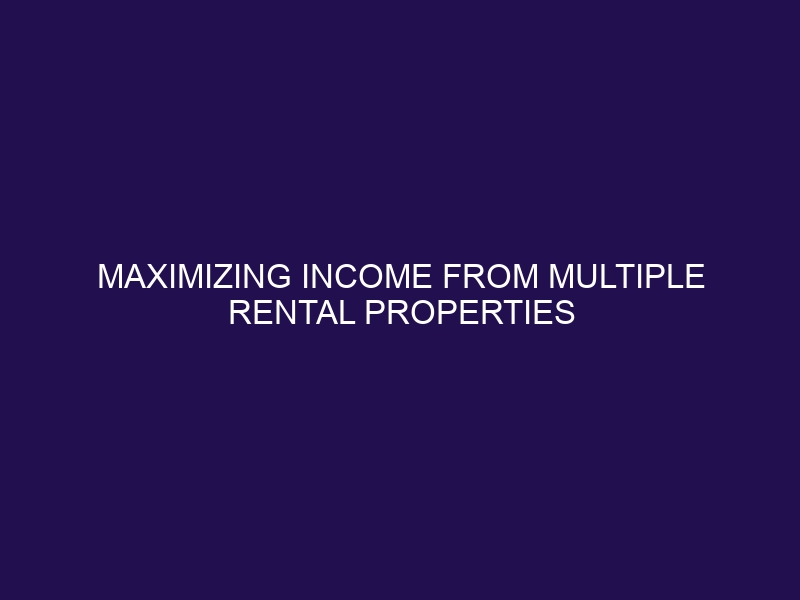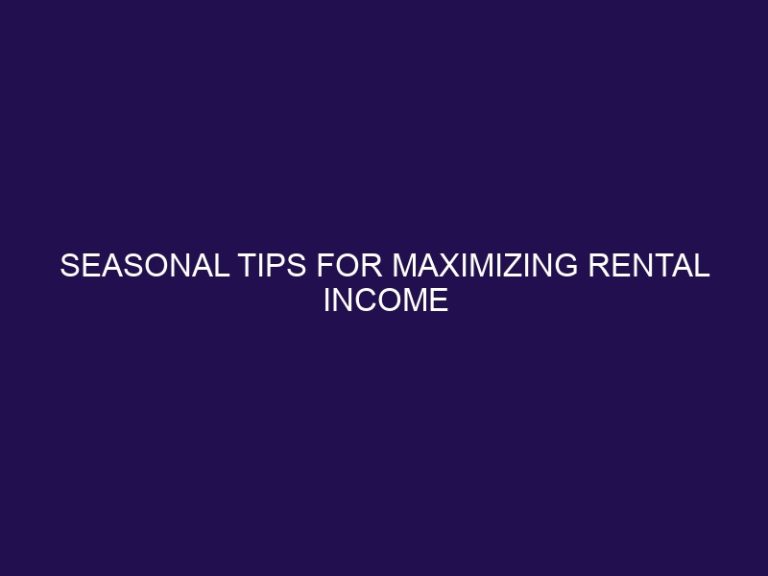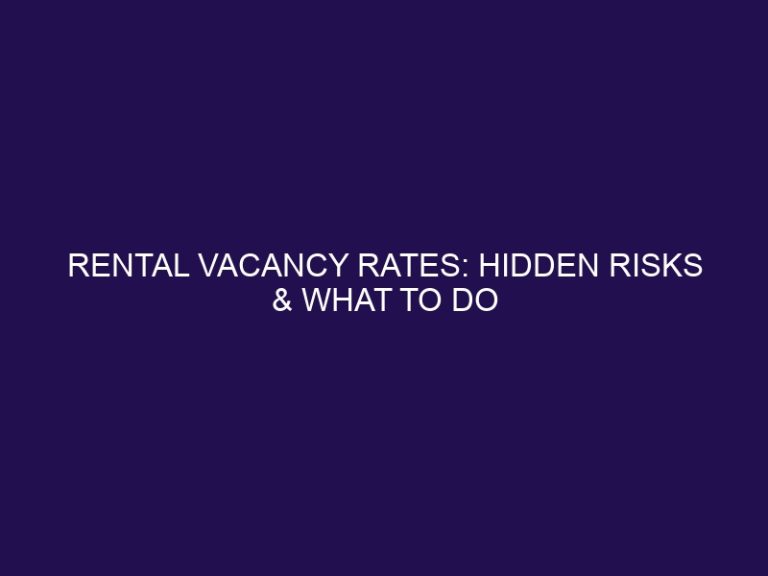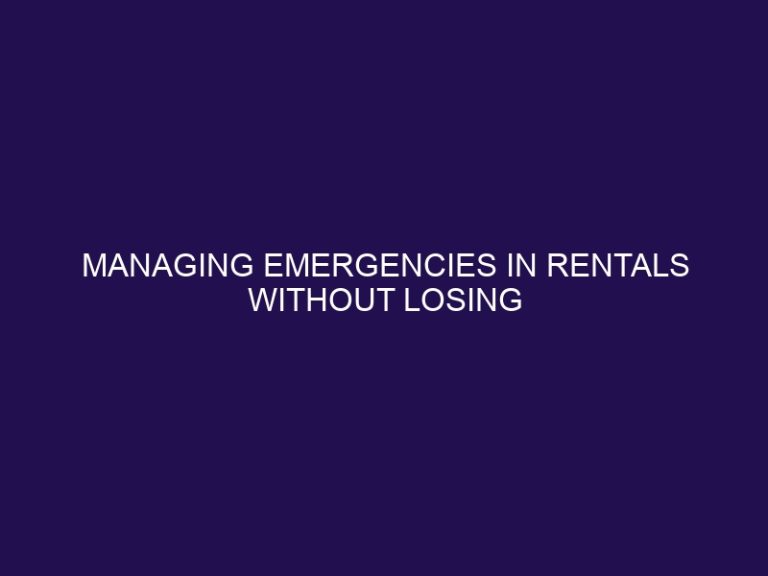Maximizing Income from Multiple Rental Properties
Multiple rental properties refer to owning and managing more than one property for the purpose of generating rental income. This can include apartments, houses, or commercial spaces. While investing in a single rental property can be a lucrative venture, owning multiple properties can offer even greater benefits. According to a study by the National Association of Realtors, 27% of investment property buyers purchased more than one property in 2019.
Investing in multiple rental properties can offer several advantages, making it a popular choice among real estate investors. Here are some reasons why you should consider investing in multiple rental properties:
- Diversification of Income: Owning multiple rental properties diversifies your income sources, reducing the risk of relying on a single property for income.
- Higher Potential for Profit: With multiple properties, there is a greater potential for generating higher income and profit compared to owning a single property.
- Tax Benefits: Rental property owners can avail of various tax benefits, including deductions for mortgage interest, property taxes, and repairs and maintenance expenses, which can help reduce tax liability.
Selecting the right properties to invest in is crucial for maximizing income. Here are some factors to consider when choosing rental properties:
- Location and Demand: Properties located in high-demand areas with a strong rental market can offer better returns on investment.
- Property Condition and Maintenance Costs: Properties in good condition with lower maintenance costs can save you money in the long run.
- Rental Rates and Potential for Growth: Research the average rental rates in the area and consider the potential for rental growth to ensure a profitable investment.
Once you have acquired multiple rental properties, there are several ways to maximize income from them:
- Set Competitive Rental Rates: Conduct market research to determine the appropriate rental rates for your properties to attract quality tenants and generate maximum income.
- Keep Properties Well-Maintained: Regular maintenance and prompt repairs can help maintain the value of your properties and keep tenants satisfied.
- Offer Amenities and Services: Providing amenities such as laundry facilities or offering services like snow removal or landscaping can attract tenants and justify higher rental rates.
- Screen Tenants Carefully: Choose reliable tenants by conducting thorough background and credit checks to avoid potential issues in the future.
- Utilize Technology for Management: Use property management software to streamline processes and reduce costs associated with managing multiple properties.
While owning multiple rental properties offers numerous benefits, there are some risks and challenges to consider, such as:
- Vacancies and Loss of Income: Vacancies can result in loss of income, and having multiple properties can increase the risk of this happening.
- Property Damage and Maintenance Costs: Owning multiple properties means more potential for damage and higher maintenance costs.
- Dealing with Difficult Tenants: Managing multiple properties also means dealing with multiple tenants, and some may be more challenging to handle than others.
In conclusion, owning multiple rental properties can be a lucrative investment strategy, but it requires careful planning and management. By selecting the right properties, utilizing effective management techniques, and being aware of potential risks, you can maximize income from your multiple rental properties.
What Are Multiple Rental Properties?
Multiple rental properties refer to owning more than one property that is rented out to tenants, generating additional income streams. These properties can include apartments, houses, or commercial spaces, and are managed to ensure steady rental yields and overall profitability. So, what exactly are multiple rental properties?
Why Invest in Multiple Rental Properties?
Investing in multiple rental properties can be a lucrative venture for those looking to maximize their income. But why should you consider investing in more than one property? In this section, we will discuss the top three reasons why investing in multiple rental properties can be a smart financial move. From diversifying your income to taking advantage of tax benefits, we will explore the various ways in which owning multiple rental properties can lead to higher profits.
1. Diversification of Income
- Investing in multiple rental properties allows for diversification of income by spreading risk across different properties and locations.
2. Higher Potential for Profit
- Research Potential Markets: Identify locations with high rental demand and potential for property value appreciation and higher potential for profit.
- Financial Analysis: Assess cash flow, property appreciation, and tax benefits to gauge profit potential.
- Evaluate Property Types: Consider diverse properties like residential, commercial, or vacation rentals for varied income streams and increased profit potential.
3. Tax Benefits
- Depreciation Deduction: Take advantage of tax benefits by claiming depreciation on the value of your rental properties.
- Mortgage Interest Deduction: Deduct mortgage interest paid for your rental properties on your tax return.
- Property Tax Deduction: Benefit from tax deductions on property taxes paid for your rental properties.
Consider consulting a tax professional to optimize the tax benefits for owning multiple rental properties.
How to Choose the Right Properties for Investment?
Investing in multiple rental properties can be a lucrative source of income, but not all properties are created equal. In this section, we will discuss the key factors to consider when choosing the right properties for investment. From the location and demand, to the condition and maintenance costs, to the rental rates and potential for growth, each aspect plays a crucial role in maximizing income from rental properties. So let’s dive in and learn how to make smart investment decisions when it comes to rental properties.
1. Location and Demand
- Research locations with high demand for rentals, such as urban areas or those near universities.
- When assessing demand, take into consideration factors like population growth, job opportunities, and available amenities.
- For insights on rental demand trends, consult with local real estate agents.
2. Property Condition and Maintenance Costs
When investing in multiple rental properties, it is crucial to assess the condition of the properties and the associated maintenance costs. It is advisable to prioritize well-maintained properties to minimize unexpected expenses. It is also important to consider the historical maintenance records and conduct thorough inspections to ensure that the properties are in good condition.
3. Rental Rates and Potential for Growth
- Conduct research on rental rates for similar properties in the area.
- Evaluate the potential for growth in property value and demand.
- Take into account economic and development trends in the location.
Pro-Tip: Continuously review and adjust rental rates to stay in line with market trends for consistent income growth.
How to Maximize Income from Multiple Rental Properties?
For those who are looking to maximize their income from multiple rental properties, there are several strategies that can help achieve this goal. By implementing these techniques, landlords can increase their rental rates, attract high-quality tenants, and streamline their management processes. In this section, we will explore five key ways to maximize income from multiple rental properties, including setting competitive rental rates, maintaining properties, offering amenities and services, carefully screening tenants, and utilizing technology for efficient management.
1. Set Competitive Rental Rates
- Conduct research on the local rental market to determine competitive rates.
- Compare the features, location, and condition of the property with other similar rentals.
- Consider offering incentives such as utilities or amenities to attract potential tenants.
- Regularly review and adjust rental rates based on market trends to remain competitive.
Pro-tip: Offering flexible lease terms can attract more tenants and increase occupancy rates.
2. Keep Properties Well-Maintained
- Regular Inspections: Schedule routine checks for property upkeep to keep properties well-maintained.
- Prompt Repairs: Address maintenance issues promptly to prevent escalation and maintain the condition of the properties.
- Landscape Care: Maintain lawns, gardens, and outdoor areas regularly to enhance the overall appearance of the properties.
- Cleaning: Ensure cleanliness of common areas and rental units to provide a pleasant living environment for tenants and maintain the value of the properties.
3. Offer Amenities and Services
- By including amenities like laundry facilities, parking spaces, or outdoor areas, you can attract more tenants.
- Furthermore, providing services such as regular maintenance, security, or community events can greatly enhance tenant satisfaction.
- Not only that, but adding amenities and services can also justify higher rental rates and ultimately improve the overall value of your property.
4. Screen Tenants Carefully
- Verify Income: Request pay stubs, tax returns, or employment verification.
- Check Rental Contact previous landlords for insights on payment history and property upkeep.
- Conduct Background Checks: Look for criminal records, eviction history, and credit scores.
Pro-tip: Consider using a rental screening service for comprehensive tenant evaluations.
- Screen Tenants Carefully
5. Utilize Technology for Management
- Implement property management software for streamlined rent collection and maintenance tracking.
- Utilize technology, including online platforms, for tenant communication, issue reporting, and remote property monitoring.
- Explore the use of smart home technology for increased energy efficiency and enhanced tenant experience.
Pro-tip: Embrace digital solutions to improve management and efficiency.
What Are the Risks and Challenges of Owning Multiple Rental Properties?
As appealing as it may seem to own multiple rental properties for a steady stream of income, there are also risks and challenges that come with this investment strategy. In this section, we will discuss these potential downsides and how to mitigate them. First, we will address the issue of vacancies and the loss of rental income that comes with them. Then, we will explore the risks of property damage and maintenance costs that can eat into your profits. Finally, we will discuss the challenges of dealing with difficult tenants and how to handle these situations effectively.
1. Vacancies and Loss of Income
- To avoid vacancies and loss of income, landlords should regularly advertise vacant properties through online platforms and local channels.
- In order to attract tenants swiftly, offer incentives such as rent discounts or flexible lease terms.
- Implementing proactive tenant retention strategies is crucial in minimizing vacancies and maintaining consistent income.
In order to mitigate the risk of vacancies and loss of income, landlords should proactively market vacancies, provide incentives, and prioritize tenant retention.
2. Property Damage and Maintenance Costs
Property damage and maintenance costs can greatly affect the income of rental properties. It is important to conduct regular inspections, promptly address repairs, and budget for unexpected expenses in order to minimize these challenges.
Fact: Landlords typically spend between 1% to 4% of a property’s value on annual maintenance costs.
3. Dealing with Difficult Tenants
- Communicate Clearly: Address concerns promptly and maintain open communication channels with tenants, especially when dealing with difficult situations.
- Set Clear Expectations: Provide written guidelines and ensure tenants understand the terms of the lease, especially when dealing with difficult tenants.
- Enforce Policies Fairly: Consistently apply rules and regulations to all tenants, regardless of difficulty.
References
When discussing rental properties, it is vital to include reliable references to back up any statements made in the content. Incorporating reputable sources and studies can strengthen the reliability and credibility of the information being presented.
Frequently Asked Questions
What are some strategies for maximizing income from multiple rental properties?
Some strategies for maximizing income from multiple rental properties include conducting thorough investment property analysis, selecting the right tenants, investing in positively geared properties, utilizing tax benefits, and regularly inspecting the properties.
How can real estate metrics be used to determine profit margins for rental properties?
Real estate metrics such as cash on cash return and capitalization rate can be used to determine profit margins and approximate return on investment (ROI) for rental properties. Online ROI calculator tools are also available for investors to use.
What precautions should landlords take to protect their rental properties from potential damage caused by tenants?
Landlords can take reasonable measures to prevent damage from daily use, such as “resident-proofing” the property with low maintenance flooring and wall mounted TVs, and providing storage space for tenants. Purchasing the right insurance, like landlord liability insurance, can also provide extra security.
How can claiming tax benefits help increase profits for rental property investors?
By deducting operating expenses and depreciation expense, landlords can reduce their taxable net income and therefore decrease the amount of taxes they owe. This can result in an increase in rental income and a higher return on investment.
What are the potential drawbacks of investing in multiple cities for rental properties?
Investing in rental properties in multiple cities can diversify risk and provide multiple income streams. However, it can also lead to higher costs of living and difficulty in managing properties remotely. It is important to carefully consider the local housing market and funds available before investing in different geographic locations.
What are some tips for landlords to maximize income and minimize risk from multiple rental properties?
Some tips for landlords to maximize income and minimize risk from multiple rental properties include creating an LLC, regularly inspecting properties, carefully screening residents, utilizing loans like hard money loans, and choosing a reliable property management company to handle day-to-day operations.







